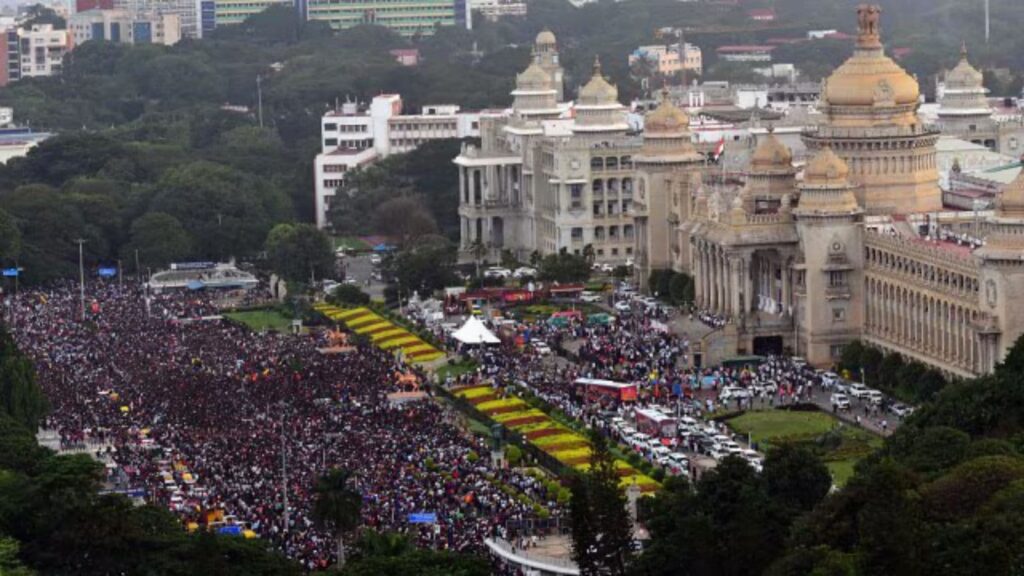The Karnataka Cabinet Thursday decided to consider clearances for a new cricket stadium after a Detailed Project Report (DPR) is prepared, following an in-principle approval by the Karnataka Housing Board (KHB) to facilitate the construction of a stadium for 80,000 spectators in rural Bengaluru.
The new cricket stadium has been projected as being necessary for Bengaluru, as the existing M Chinnaswamy Stadium, operated by the Karnataka State Cricket Association, has a capacity of only 33,000 spectators.
The Cabinet mentioned in a note on Thursday, “The Karnataka Housing Board has given in-principle approval to the implementation of the project of an international-level cricket stadium and complex on a 75-acre plot of land in Indlavadi village under the Comprehensive Development Plan in Suryanagar-4th Phase Layout, Bangalore City, at a cost of Rs 2,350 crore. The KHB has been asked to present it again before the Cabinet for a decision after a detailed project report.”
“The Chinnaswamy Stadium in Bengaluru is old and has a capacity of only 38,000. Many cities, both big and small, have stadiums that are bigger than Bengaluru. A Bengaluru Stadium, which meets the needs of the city with all the modern facilities, is a must for the city,” it further said.
In arguments in the Karnataka High Court in a suo motu case taken up by the court over the stampede deaths, the state advocate general told the court that the cause of the stampede was the nearly 2.5 lakh fans trying to access the stadium, which can accommodate 33,000 fans.
“The event (at the stadium) was organised on behalf of RCB by DNA Event Management. KSCA is in charge of the stadium. All the security is provided by them in the stadium. All the deaths happened at the entry gates of the stadium. The problem is that 33,000 people were expected – which is the capacity of the stadium – but 2.5 lakh people turned out,” Advocate General K M Shashikiran Shetty told the Karnataka High Court.
Story continues below this ad
Karnataka Chief Minister Siddaramaiah, who is an avid cricket enthusiast and often watches matches at the KSCA stadium in Bengaluru, was also asked after the stampede regarding the capacity and traffic problems linked to the present stadium, and he responded, saying, “The government will look into this matter.”
According to senior state officials, including those from the police department, “the long-term solution to prevent incidents like the stampede is the relocation of the cricket stadium to a higher capacity facility somewhere on the outskirts of the city.”
Judicial commission recommendation on Chinnaswamy Stadium
The Justice John Michael D’Cunha judicial commission set up to probe the June 4 stampede at the M Chinnaswamy Stadium has recommended that no major public events should be held at the stadium till safety measures are installed.
The commission recommended the introduction of several measures at the stadium – including adequate entry and exit gates, integration with public transport facilities, and infrastructure for emergency responses – before conducting any future public event.
Story continues below this ad
“Until such infrastructural changes are made, continuing to host high-attendance events at the current location poses unacceptable risks to public safety, urban mobility and emergency preparedness,” the judicial commission has said in a recommendation made in a report submitted to CM Siddaramaiah on July 11.
The commission stated in its report that without addressing “systemic limitations” at the Bengaluru cricket stadium – located in the heart of the city on the M G Road – it would not be appropriate to hold large public events at the stadium.
Given the systematic limitations, “the commission strongly recommends that stadium authorities consider relocating events that are expected to attract large crowds to venues that are better suited for such large gatherings,” the report has stated.
“The design and structure of the stadium were unsuitable and unsafe for mass gathering. All the entry and exit gates were directly opening into the public footpath. Spacious and organised holding area for crowd were not provided at the entry, as a result, the audience were forced to queue up on the footpath or the road abstracting and endangering the pedestrians and vehicular movements as well as giving scope for the miscreants to join the crowd aggravating the risk especially in the absence of proper security management,” the Justice D’Cunha commission report said.

